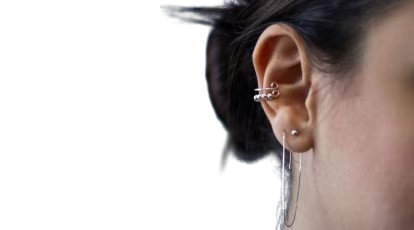Ear piercing Expert in Perumbakkam
Your Trusted Partner in Ear piercing
A new ear piercing is an open wound that can take several weeks to fully heal. During that time, any bacteria that enter the wound can lead to infection. Taking good care of your piercing is key to preventing infection. We are here to provide you with top-notch care and guidance to tackle your problems.

Understanding Ear piercing
What is an infected Ear Piercing?
An ear piercing is a hole through your earlobe or the cartilage in your middle or upper ear. Ear piercing infections may be red, swollen, sore, warm, itchy or tender. Sometimes, piercings ooze blood or white, yellow or green pus.
A new piercing is an open wound that can take several weeks to fully heal. During that time, any bacteria that enter the wound can lead to infection.
Types of Ear Piercing infections
The two main types of ear piercings are through your earlobes and through the cartilage of your ear.
Your earlobes are fleshy and fatty, with strong blood flow. They heal quickly, reducing the risk of an infected earlobe piercing.
Your upper ear is cartilage, a thick, stiff tissue with less blood flow. Piercings in your upper ear are more likely to become infected, and infections in your upper ear are sometimes serious.
How common are Ear infections from Piercing?
Millions of people get their ears pierced every year, and most of them have no serious complications. Mild irritation and infections are common, however, for new piercings. In most cases, infections aren’t serious and clear up quickly.
In one study, as many as 35% of people with pierced ears had one or more of the following complications:
- Minor infection: 77%.
- Allergic reaction: 43%.
- Scar tissue (Keloid) formation: 2.5%.
- Traumatic tearing: 2.5%.
What does an infected Ear Piercing look like?
Some pain and redness are part of the normal healing process for pierced ears. It can be easy to confuse those with signs of infection.
If there’s a bump on the back of the ear piercing, it’s not necessarily infected. Small bumps called granulomas can sometimes form around the piercing. These bumps are trapped fluid that you can treat by compressing them with warm water.
You know your ear piercing is infected if you have symptoms such as:
- Discharge coming out of your piercing.
- Fever.
- Redness, warmth or swelling around your piercing.
- Tenderness in your pierced earlobe or cartilage.
What causes infected Ear Piercing?
If bacteria get into a new piercing, it can lead to infection. You may expose your new piercing to harmful bacteria by:
- Getting your ears pierced in an unhygienic environment or with unsterilized equipment.
- Touching your ears with dirty hands.
- Removing your earrings before your piercing heals.
- Neglecting to clean your new piercing daily.
- Swimming or submerging your head in a pool, hot tub, lake or river before your piercing fully heals.
What are the complications of infected Ear Piercing?
Leaving an infected piercing untreated can result in a more severe infection or an abscess(a swollen area filled with pus).
Upper ear piercings are more likely to get infected. Left untreated, these infections can lead to a condition known as perichondritis. An infection can also spread into your body (systemic infection).
In some cases, an infection can cause your piercing to close up.
Frequently Asked Question on Ear Piercing
It’s possible to get multiple piercings done during a single session, but it’s important to consider factors such as pain tolerance, healing time, and aftercare requirements. Discuss your preferences and concerns with a professional piercer before proceeding.
